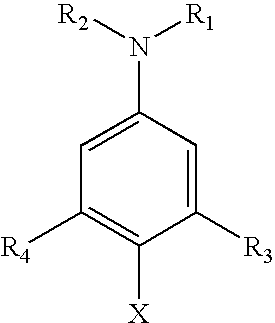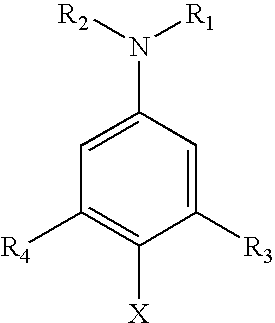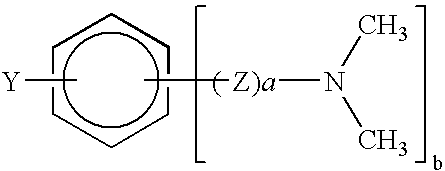Dual cure adhesive formulations
a technology of adhesive formulation and cure time, applied in the field of adhesives, can solve the problems of increasing the cost of cleaning, rising to unique requirements not easily met by previously available adhesives,
- Summary
- Abstract
- Description
- Claims
- Application Information
AI Technical Summary
Benefits of technology
Problems solved by technology
Method used
Image
Examples
example 1
[0095]The following masterbatch was prepared:
[0096]A-side
Raw MaterialDescriptionAmount (wt. %)Monomer 133.79Monomer 22.4Tertiary amine1.4initiatorPhotoinitiatorX % (see below)Adhesion promoter3.0Rheology modifier5.4Stabilizer0.01Rubber toughener34.5Filler16.3Wax1.2Total~100.0
[0097]B-side
Raw MaterialDescriptionAmount (wt. %)Epoxy resin50.7Benzoyl peroxide7.7(BPO) sourceRheology modifier1.0Filler40.6Total100.0
[0098]This adhesive was mixed in a 4:1 ratio by volume and dispensed in a bead configuration (¼″ wide×⅛″ thick×3″ long) onto an aluminum substrate and passed through a UV cure unit at various energy levels. Samples were observed for a tack-free surface immediately after exposure to UV radiation and 24 hours after exposure. Photoinitiator levels given in the following table are a percentage of the adhesive after the two sides A and B were mixed.
PI levelUV energyPhotoinitiator(wt %)(mJ / cm2)Initial tack24 hr. tackNone (control)0723tackytacky1012tackytackyPhotoinitiator2.0701tack fre...
example 2
[0099]A bead of the above masterbatch with 1 percent Photoinitiator B added to the A-side was applied to a substrate and was cured for 24 hours at ambient temperature. The cured adhesive, which had a thin film of uncured adhesive at the surface, was exposed to 600 mj / cm2 of UV radiation. The surface was rendered tack-free. The sample was then painted. After the paint had completely cured, a crosshatch adhesion test was performed according to ASTM F 1842-02, and the resulting adhesion was excellent.
example 3
[0100]The following photoinitiators were added at 2 and 4-weight percent to the A-side of the above masterbatch and were mixed thoroughly.[0101]1. No Photoinitiator[0102]2. Photoinitiator C (blend of 2-isopropyl and 4-isopropyl thioxanthone)[0103]3. Photoinitiator D (2,4,6-Trimethylbenzoyldiphenylphosphine oxide)
[0104]Each of these materials was mixed at 4:1 by volume with the above masterbatch B-Side and dispended into a 0.25″ wide bead and allowed to cure at ambient temperature for 60 minutes. After cure, the surfaces of all samples were tacky. All samples were then exposed to UV light at an intensity of 2000 mJ / cm2. The surfaces of both samples of #2 and #3 were tack-free, while the surface of #1 remained tacky.
PUM
| Property | Measurement | Unit |
|---|---|---|
| Percent by mass | aaaaa | aaaaa |
| Percent by mass | aaaaa | aaaaa |
| Percent by mass | aaaaa | aaaaa |
Abstract
Description
Claims
Application Information
 Login to View More
Login to View More - R&D
- Intellectual Property
- Life Sciences
- Materials
- Tech Scout
- Unparalleled Data Quality
- Higher Quality Content
- 60% Fewer Hallucinations
Browse by: Latest US Patents, China's latest patents, Technical Efficacy Thesaurus, Application Domain, Technology Topic, Popular Technical Reports.
© 2025 PatSnap. All rights reserved.Legal|Privacy policy|Modern Slavery Act Transparency Statement|Sitemap|About US| Contact US: help@patsnap.com



